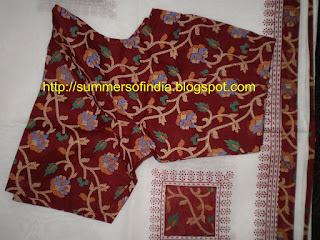Batik is a traditional dyeing technique. Wax is used to resist the colour(s) to form the design. Its quite laborious. But history reveals that there were proofs of using this technique by Egyptians as early as 4th century BC to produce cloth for wrapping mummies. This art is found in Java Indonesia, Malaysia, China Japan, India and Africa. But the most popular ones are from Java.
The word "Batik" is said to originate from Java. It is pronounced as "Bateek". It means written with wax.
The word "Batik" is said to originate from Java. It is pronounced as "Bateek". It means written with wax.
The procedure involves use of hot wax. One has to work very quickly and efficiently since the wax keeps on solidifying.
But the beauty in this art depends on the fact that one need not be a great artist. Just basic skills of drawing or sketching can be enough. First planning and making a sketch and then using the design is ok, but then many a time just being spontaneous produces some beautiful pieces.
Generally natural fabrics like pure cotton or silk cloth is used. Any natural fiber like jute or linen are also fine. The synthetic ones wont dye properly. The finer the cloth, the intricate the design. But silks are expensive and difficult to handle for the beginners. Fine cottons are there fore extensively used.
Generally natural fabrics like pure cotton or silk cloth is used. Any natural fiber like jute or linen are also fine. The synthetic ones wont dye properly. The finer the cloth, the intricate the design. But silks are expensive and difficult to handle for the beginners. Fine cottons are there fore extensively used.
A mixture of Bee wax and Paraffin wax is used. Bee wax has the tendency to seep into the cloth thereby attaching itself to the cloth. Paraffin wax is very brittle and cracks easily, helps in producing the crackling effect for which the Batik so famous for. An ideal mix would be 30: 70, but it can be varied to suit the design and the effect.
The cloth is fixed to a frame to keep it taut. After tracing the design, hot wax is applied with brush in those areas where the colour to be dyed is not required. Once the areas in the design are filled, the cloth is wrinkled to produce the crackling effect. Then it is dyed, obviously in cold dyes as hot ones melt the wax. Once dipped in dye, its not squeezed but let to dry naturally. This process of applying wax in unwanted areas and dyeing is continued till required design is got. Then its is dipped in hot water to get rid of the wax.
In India, West Bengal is very famous for its Batiks. Wall hangings, bedsheets, pillow cases, dresses made out of these materials and especially saris and blouses are quite famous. Sometime ago I visited one of the exhibitions conducted by our textile ministry and happened to pick up some Batik blouses. I also have some saris, but need to photograph them. I just cant resist a beautiful Batik. These two here are blouses.

See this combination of green and black. this design is on the sleeves.

Here see the design on the neck. So beautiful.

This is a dark purple, and design is on the neck line.

These are the sleeves.

This one here is a long kurtha or tunic with mirror work. See the paisley design.

The cloth is fixed to a frame to keep it taut. After tracing the design, hot wax is applied with brush in those areas where the colour to be dyed is not required. Once the areas in the design are filled, the cloth is wrinkled to produce the crackling effect. Then it is dyed, obviously in cold dyes as hot ones melt the wax. Once dipped in dye, its not squeezed but let to dry naturally. This process of applying wax in unwanted areas and dyeing is continued till required design is got. Then its is dipped in hot water to get rid of the wax.
In India, West Bengal is very famous for its Batiks. Wall hangings, bedsheets, pillow cases, dresses made out of these materials and especially saris and blouses are quite famous. Sometime ago I visited one of the exhibitions conducted by our textile ministry and happened to pick up some Batik blouses. I also have some saris, but need to photograph them. I just cant resist a beautiful Batik. These two here are blouses.

See this combination of green and black. this design is on the sleeves.

Here see the design on the neck. So beautiful.

This is a dark purple, and design is on the neck line.

These are the sleeves.

This one here is a long kurtha or tunic with mirror work. See the paisley design.
















